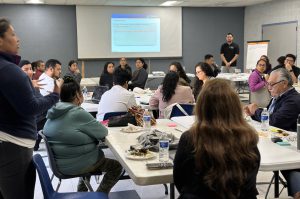
Celebrating 10 Years of SLATE-Z
Celebrating 10 Years of SLATE-Z A Legacy of Cultural Richness South Los Angeles has long been a place of cultural vibrancy, tracing its roots to
Variable Definitions:
Opportunity Youth: The percent of youth ages 16 to 24 who are neither working nor in school
Methodology Note:
The calculation of this dataset requires a multi-step calculation combining ACS demographics data and IPUMS individual-level school/employment data. The full methodology documentation can be found here.
Source:
American Community Survey (ACS) and The Integrated Public Use Microdata Series (IPUMS-USA)
Years Available:
2010-2023
*Note: Each year of available data shown above is a 5-year estimate, or an average of data collected over a five year period. 5-year estimates are used to increase the reliability of the data at small geographies like neighborhoods and census tracts. The years shown on the NDSC map represent the final year of the five year average (e.g. “2010” represents 2006-2010 data, “2011” represents 2007-2011 data, and so on). For the most impactful comparison of data over time, the ACS recommends comparing non-overlapping years (e.g. 2010-14 with 2015-19).
Opportunity youth (also referred to as disconnected youth) are individuals between the age of 16 and 24 who are neither working nor in school. Such youth often leave school or work because of healthcare issues, pregnancy, the need to take care of younger siblings or caretakers, or because they are struggling and disconnected in school.
Lewis, Kristen. (2021) “Building Bright Futures for Youth in Los Angeles: Spotlight on Young Women.” Measure of America. Link.
Fogg, Neeta, and Paul Harrington. “The Human Capital Investment Gap: Understanding the Diminished Prospects of Disconnected Youth in Los Angeles.” Drexel University Center for Labor Markets and Policy (2016). Link.

Celebrating 10 Years of SLATE-Z A Legacy of Cultural Richness South Los Angeles has long been a place of cultural vibrancy, tracing its roots to

Advancing a Collaborative Agenda in Southeast LA In 2022, the California Community Foundation (CCF) launched the Regional Recovery Hub to strengthen place-based coordination in Los Angeles County

In 2022, the California Community Foundation (CCF) launched the Regional Recovery Hub to strengthen place-based coordination in Los Angeles County regions that were most heavily impacted by
